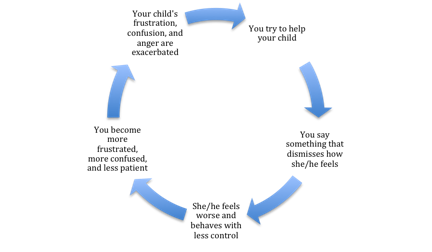
It can be challenging for any of us to see a friend, family member, or loved one upset. It can be especially difficult for a parent to see their child this way. Often parents find themselves wanting to “fix” or “solve” the problem for their child so that they are no longer upset.
If you are a parent, you may have heard or said things like, “Don’t feel that way, everything will be alright” or “It’s not that big of a deal, you’ll be fine.” Most parents think they are helping their upset child with statements like that, however, what ends up happening is that the child is left feeling unheard and at times, he/she feels the same or possibly worse.
When we are not acknowledging the child’s experience, we are “invalidating” the child. Often parents believe that they have been validating their child all along. Some common mistakes parents make include, validating the child’s feelings, followed by something negative or what he/she did wrong.
For example, “I’m sorry you’re feeling sad about your breakup, but you and your boyfriend were only together for a month.” Or parents also tend to give their children compliments when he/she is struggling with a situation. This type of behavior appears to be supportive because you’re sharing compliments with your child.
For example, your teen comes home from school telling you that he/she was being teased about his/her appearance. You immediately tell he/she how beautiful, kind, loving, and special he/she is to you. This would seem like you are validating your child, however, you’re not acknowledging the fact that he/she was being teased by his/her peers.
What’s the opposite of invalidating? Validation, but what is validation? Validation simply means accepting the child’s experience for what it is, even if you don’t agree with it, even if it doesn’t make sense to you. Validation is all about understanding that your child did “x” or “y” because he/she thought about something, felt something, etc.
Why is validation important? Frequent invalidating statements or behaviors lead the child to be unsure about what’s the right way to feel or think, creates frustration because of this ongoing feeling of being misunderstood or unseen, and it could easily evolve into distrusting his/her own experience to the degree that he needs to check with others whether what he/she is feeling right or not or if it’s too much or too little.
When a child receives invalidating statements they are not only learning that their feelings are wrong but also that something is wrong with them. Telling a child that the she doesn’t or shouldn’t feel “x” is like saying “the sky shouldn’t be blue.” Whether you like or not, whether you understand or not, your child’s feelings are real; rejecting, changing, minimizing or denying his/her feelings is rejecting reality.
Here is our general recommendation to start practicing validation:
“First accept the feelings, then address the behavior”
Now here are specific recommendations to improve your ability to make validating statements:
- Pay attention to your verbal and nonverbal reactions, which can communicate invalidation to your child. Parents should watch out for your own behaviors such as eye rolling, teeth sucking, heavy sighing, walking about, and making light statements of something serious for your child such as “you shouldn’t feel that way; cheer up; it’s not a big deal; move on.”
- ASK and ask again. You can use short questions such as “really? how come? How did it happen? How’s that? You can also use long questions such as “What bothers you the most about it? What else bothered you? What else did you feel? What would help you feel better?”
- Make validating statements such as: “I understand that you’re having a difficult time today; I can see why you feel that way you feel; It’s very difficult; I may feel the same way if I were in your shoes.” Important tip: when making a validating statement, focus on validating the feelings, thoughts, and behaviors of your child, in other words “validate the valid.” An example of a validating the valid would be the following: “I understand that you’re feeling upset about the low test grade on your test.” When using this sentence you are validating the feeling of being upset not the lack of studying that led to the low grade.
You may not correctly validate your child or use a validation techniques that works for he or she the first time; in fact, it may feel counterintuitive to do it. However, remember that practice, practice, and more practice will not only improve your validating skills but also will help your child to develop emotional wisdom.
References
Harvey Pat, LCSW-C and Penzo, Jeanine A. (2009). Parenting a Child Who Has Intense Emotions. Oakland, CA. New Harbinger Publications, Inc.






